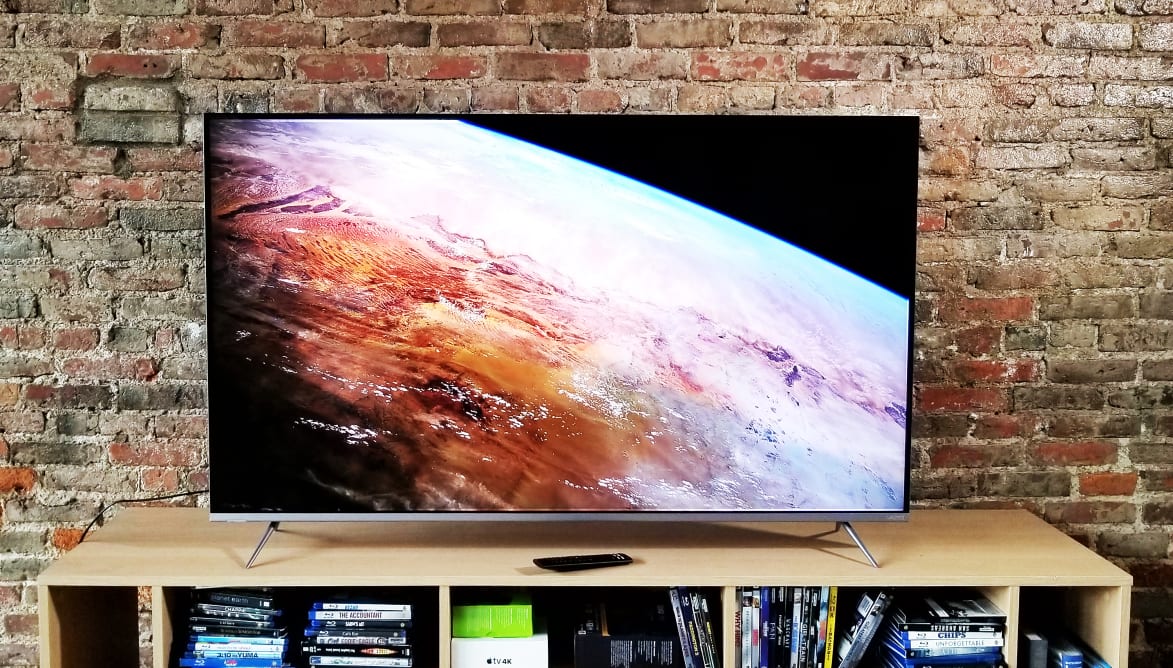Pros
-
4K resolution and HDR support
-
Google SmartCast features and five HDMI inputs
-
Elegant silver design
Cons
-
Large discrepancies between black levels
Also in accordance with tradition, Vizio intends to roll out quick and impactful firmware updates to the P-Series again this year, addressing everything from HDR peak brightness to additional smart features. But while I intend to update this review vigorously over the next 1-2 weeks, it's safe to say my initial experience is that this TV kicks major butt.
You're getting higher brightness and more color than the 2017 P-Series, a better design, and more far-reaching smart features. And while I can only comment with certainty on the 55-inch we tested, the local dimming was absolutely incredible, a real testament to the work that Vizio has done in recent years honing its local dimming algorithm. If that sounds like your cup o' tea, keep your eye on the P.
About the Vizio P-Series
Vizio's P-Series is available in three screen sizes:
- 55-inch (Vizio P55-F1), $800
- 65-inch (Vizio P65-F1), $1,200
- 75-inch (Vizio P75-F1), $2,300
As some of Vizio's best 2018 TVs, the P-Series TVs are well-equipped in terms of their specifications and features:
• 4K (3,840 x 2,160) resolution • High Dynamic Range (HDR10 & Dolby Vision) • Full-Array Local Dimming LED backlights • 56/100/120 local dimming zones (size dependent) • SmartCast (Google cast) internet features • 120 Hz native refresh rates • Amazon Echo/Google Assistant compatible • Free streaming TV (advertised, not yet available)
On paper, you're getting a lot of good, future-facing TV tech for what you're paying—which has been the motto of the P-Series for the last few years. But if what was on paper translated to the actual TV screen, I wouldn't have a job.
We bought our 55-inch Vizio P-Series from Best Buy, and ran it for 24 hours prior to running lab tests.
The Pros
Dressed for success
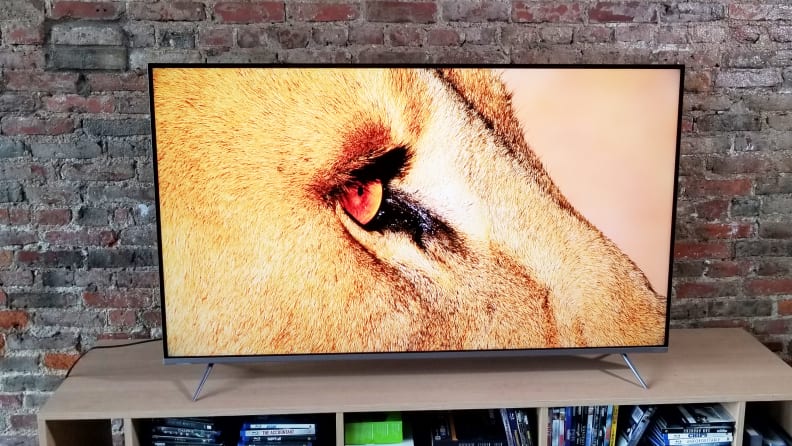
The 2018 Vizio P-Series looks better than ever. I really like how slimmed down and pointy the tabletop feet are this year.
Vizio's 2018 P-Series looks really good this year. It's all smooth, sturdy silver from the bezels to the sharp, caltrop-like feet. The rear of the TV is the usual charcoal-colored plastic, but it's inlaid with filigree and patterns that dance from one side to the other. Our 55-inch is particularly striking and sleek, even for a TV with a full-array LED backlight.
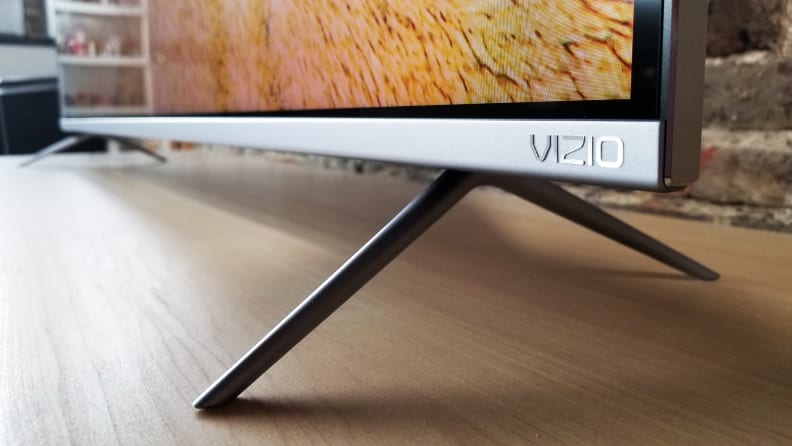
The feet sit almost at the very edges of the display, so measure your tabletop stand if you're thinking of buying. That's doubly true for the 65- and 75-inch models.
The remote isn't anything too special, but if you like your remote to have a robust button selection, Vizio's got yer back matey. This mid-sized remote control's main feature are its six dedicated app buttons (for Vudu, Netflix, Amazon, Xumo, Crackle, and iHeartRadio).
You'll find the standard number pad and rockers for volume and channel, too. It's not my favorite remote, but it gets the job done.
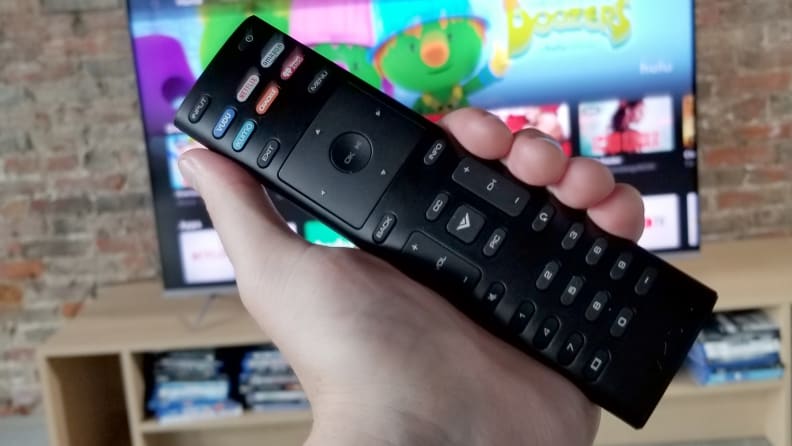
The included remote isn't my favorite, but it does have a lot of useful app hotkeys. I'm still not sure what Xumo is, though, and I do this 40 hours a week.
This year's P-Series still has a robust port selection. You get five HDMI inputs! You'll also find a single USB 2.0 port (on the 55-inch, anyway), shared component/composite inputs, a LAN (ethernet) input, and both optical and analog audio outs.
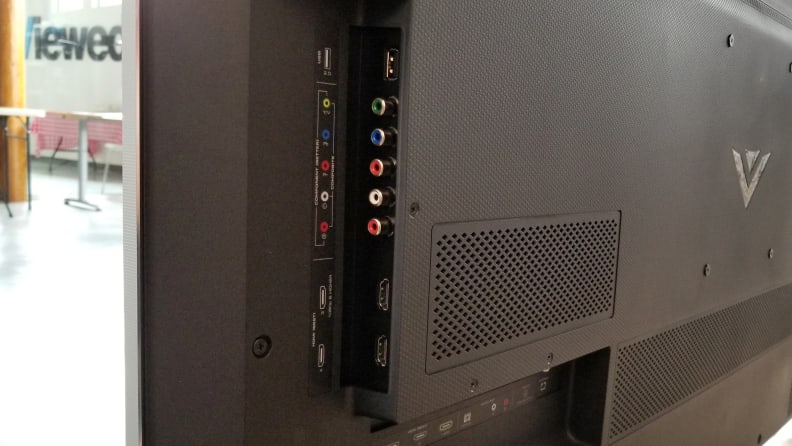
The P-Series still has 5 HDMI inputs, plus all the legacy video connections. Internal antennas are back this year, too.
Last but definitely not least, this year the P-Series (and all of Vizio's 2018 models) have built-in digital tuners again, so external satellite/antenna users won't have to find any workarounds.
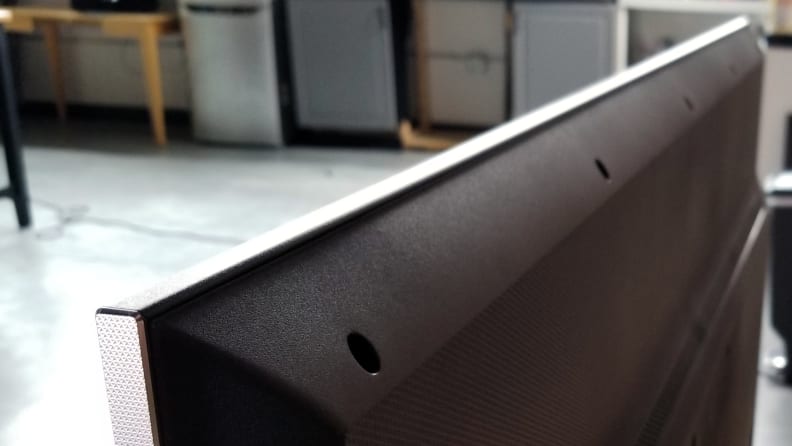
The P-Series isn't the thinnest TV in profile, but it's still pretty compact and flush for being a full-array local dimming model.
The final verdict? The 2018 P-Series improves upon the 2017 model's design and physical attributes in just about every category.
However, as always I only have a single sample size. Sound off in the comments or shoot me an email if you've had a different experience!
Rock solid picture quality
The first thing we did when Best Buy delivered the 55-inch P-Series was set it up on a table adjacent to our editorial area. TVs almost never get brought upstairs to the ol' bullpen, so this was pretty exciting for me. Assembly was easy, and after a brief setup, the TV was on (in "retail" mode) playing its demo reel.
The next half hour was interesting, because almost every single person who walked into the room ended up wandering over, mesmerized, by the P-Series' flashy picture. While this might be a testament to how much my co-workers need to upgrade their TVs at home, it's also a testament to how good the 2018 P-Series looks.
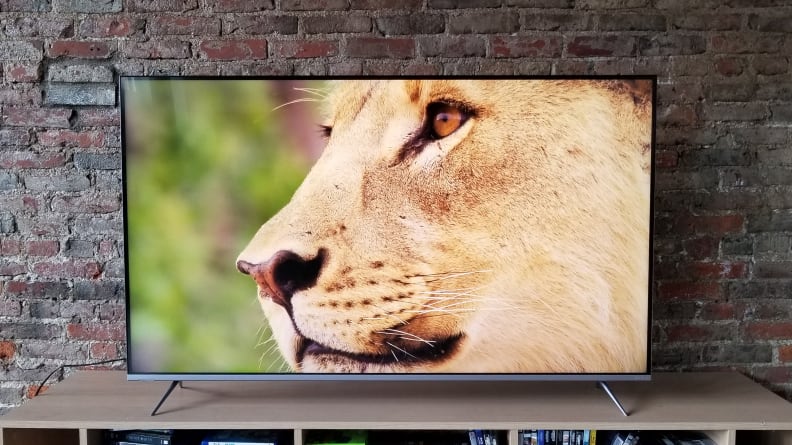
Overall, the P-Series is one of the better-looking LED TVs I've seen all year, even outside of HDR mode. The 55-inch does a lot with not a lot of dimming zones.
Time in the lab corroborated a lot of what I expected to see by knowing the TV's specs in advance. While this TV performs admirably during standard dynamic range (SDR) content, it really shines—heh heh—while playing HDR content.
It doesn't have the quantum dots of the P-Series Quantum (or one of Samsung's QLED models), but it's still very bright and colorful.
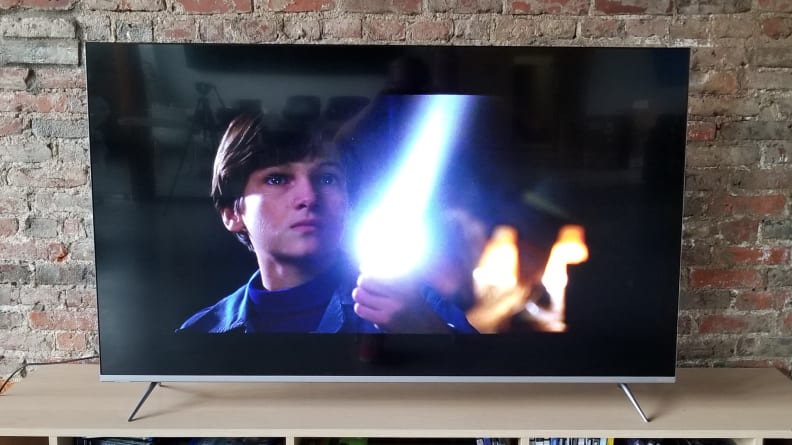
Initial firmware yielded HDR peaks around 950 nits, which is pretty amazing for a TV that doesn't have quantum dots.
One of the biggest concerns from AV enthusiasts about the 2018 P-Series lineup is that it has less local dimming zones than the 2017 model. The 2017 55-inch Vizio P-Series had 126 local dimming zones, while our 55-inch 2018 model has 56, which is remarkably less.
Despite that, I was very impressed by the P55-F1's local dimming. I threw some really difficult APL-based test patterns at it (basically, a tiny 1 or 2% white square in the middle of the screen, while the rest of the screen is black). I slowly increased the size of the square in one-percent degrees, watching as the P-Series' ABL (auto brightness limiting) slowly relented and the squares got brighter and brighter—a system which has some drawbacks that I'll cover in the next section.
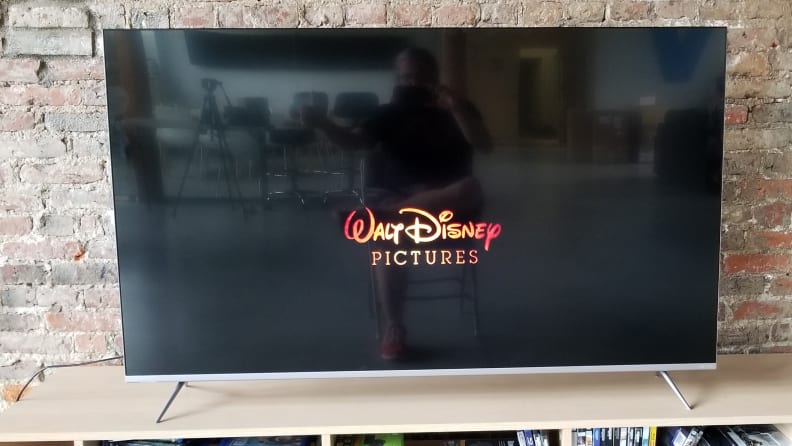
Thumbs up! The P-Series' local dimming is excellent, showing almost zero flashlighting or blooming. Reflectivity might be a different matter if your room has lots of light, though.
Nevertheless, I struggled to spot even a hint of the blooming or flashlighting that very often affects TVs with a lower amount of local dimming zones. This doesn't mean you won't see any yourself—I watched and tested the P-Series primarily in Calibrated Dark mode, which is probably the darkest mode even in HDR—but they were impressive results nevertheless.
On top of its local dimming, the P-Series was also a strong performer where color accuracy and motion handling is concerned. Because all of the P-Series sets have 120 Hz panels, they're adept at handling many flavors of motion, from Blu-rays that play at 24 fps to basic cable programming and video games.
Finally, this is definitely a very solid TV for 4K/HDR viewing. The data is below, but suffice to say the P-Series looks like one of 2018's best choices in terms of HDR performance.
All in all, despite having less zones than the 2017 model, the 2018 P-Series is as good (or better) in just about every major picture quality category.
Performance Data (Calibrated Dark mode)
- SDR Black Level: 0.05 nits
- SDR Reference Brightness: 195.10 nits
- HDR Black Level: 0.08 nits
- HDR Peak Brightness: 949.30 (as of 6/18/18)
- SDR Color Gamut coverage: 99%
- HDR Color Gamut coverage: 93% (as of 6/18/18)
Pick your home assistant of choice—er, not you Bixby
The P-Series continues to use the "Vizio Cast" smart system, which is basically just Google Cast but with elements that are proprietary to Vizio. In summary, you can control the P-Series with your phone and cast any content to the screen that you could cast using Google Cast. The TV also has apps like Netflix and YouTube pre-installed, so you won't have to do much tinkering if you don't want to. It's a simple, clean system that may not wow anyone, but you won't mind that it's part of the TV.
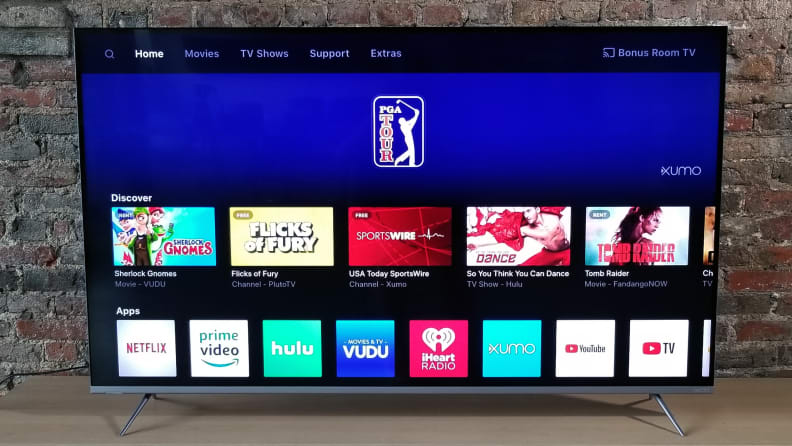
Vizio continues using the "Vizio Cast" (Google Cast-based) smart platform this year. It's swell, but it isn't a huge selling point.
What's new this year is that the P-Series (and most of Vizio's 2018 lineup) is now compatible with both Alexa and Google Home, the integrated voice assistants for Amazon and Google—guess we need to add Vizio TVs to the long list of everything that works with Alexa.
Whether or not you use one of those assistants already and how smartly "integrated" your home is obviously affects the appeal of this feature, but as a jumping off point, it's a great addition to the TV's list of features.
The Cons
A lower zone count = less consistent black levels
Because of how local dimming works on LED TVs, more zones are always better. With TVs with full-array LED backlights like the P-Series, the more zones of dimming available, the better the contrast.
However, there is a drawback to this that can sometimes bother attentive viewers: large discrepancies between black levels depending on how much of the screen is dark.
Like most TVs with full-array local dimming, when the P-Series is displaying mostly black, it's much darker than when only a small portion of the screen is black. While this isn't hugely distracting, it is one way emissive displays like OLEDs are inherently superior to LED TVs—each pixel is essentially its own local dimming zone.
Poor horizontal viewing angle
Another drawback often related to effective (or aggressive) local dimming is worse off-angle viewing. For our P55-F1, this means a pretty limited horizontal viewing angle.
You could still watch with buddies on the couch, but in a large room, wide off-angle viewing (or wall-mounting the TV) might have you seeing diminished contrast or off-angle color shifting.

Horizontal viewing angle is one of the P-Series worst attributes. This isn't as big of a deal on the 55-inch, but I have to hope the 75-inch fares a bit better.
Performance Data (Calibrated Dark mode)
- SDR 90% Black: 0.002 nits
- SDR 10% Black: 0.06 nits
- HDR 90% Black: 0.008 nits
HDR 10% Black: 0.099 nits
Horizontal Viewing Angle: 10.71° or ±5.36° from center to either side of the screen
Should you buy it?
Yes—if you want a stylish HDR TV for way less than the competition
If you're looking to upgrade or update your TV experience this year, the 2018 Vizio P-Series should be a consideration. The P-Series' pristine picture quality, svelte silver design, and forward-facing features work together to create a very solid product overall.
At $800 for the 55-inch, $1,200 for the 65-inch, and $2,300 for the 75-inch, you're paying a lot less than you normally would for this level of polish and such a powerful HDR experience.
Did I miss anything? Are you an owner with a different experience? Please comment or shoot me an email.
...If you want to spend less
If you don't mind giving up some of the P-Series' power (and its swanky design), check out my review of the TCL 6 Series.
The 55-inch TCL 6 Series is only $650, but the P-Series is the better performer.
...If you want more HDR performance
If you want an even brighter, more colorful TV, check out my review of the Samsung Q8F—you're not going to do much better than the P-Series without quantum dots on board.
Just keep in mind Vizio's "P-Series Quantum" should be available soon, too.
Meet the tester
Lee was Reviewed's point person for most television and home theater products from 2012 until early 2022. Lee received Level II certification in TV calibration from the Imaging Science Foundation in 2013. As Editor of the Home Theater vertical, Lee oversaw reviews of TVs, monitors, soundbars, and Bluetooth speakers. He also reviewed headphones, and has a background in music performance.
Checking our work.
Our team is here to help you buy the best stuff and love what you own. Our writers, editors, and experts obsess over the products we cover to make sure you're confident and satisfied. Have a different opinion about something we recommend? Email us and we'll compare notes.
Shoot us an email
